I Tried the Dutch Pastime of Mudwalking Across the Sea — Here’s How You Can, Too
Each summer, thousands of people walk across the Wadden Sea, in the northern Netherlands. Here's how I learned to embrace the quirky Dutch sport of "Wadlopen."
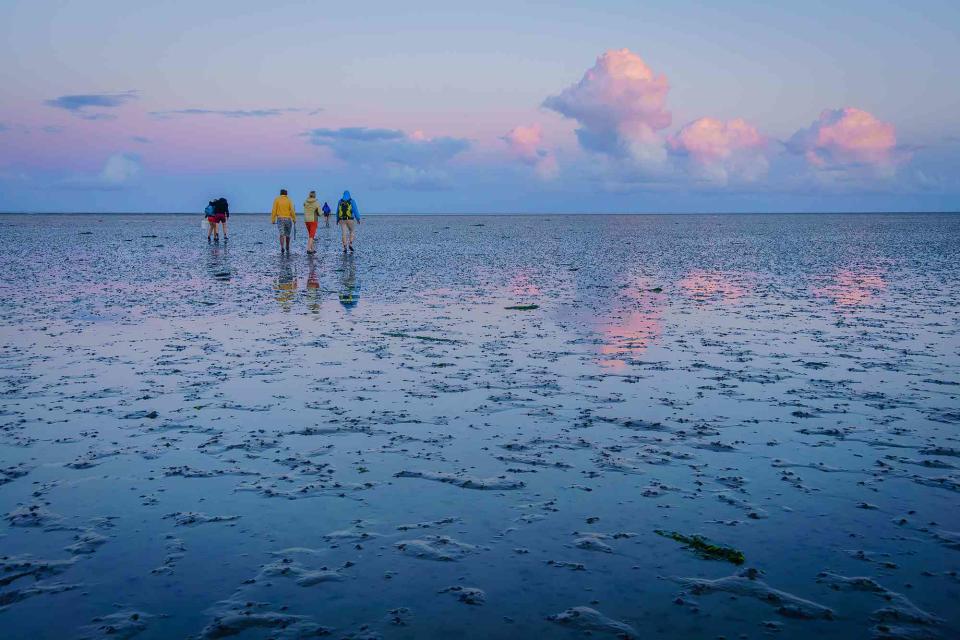
Fredrik Nilsson/Getty Images
Walking through the mud in the Wadden Sea, in the Netherlands.Standing on the last firm land before the Wadden Sea, I braced myself. I expected the mud to be cold when it hit my bare shin. Instead, the slik, as the Dutch call the mud here, was silky and tepid. I took a deep breath, then my next step, striking out to cross the sea.
I’d come to the northern coast of the Netherlands to partake in this quintessential Dutch pastime, called wadlopen, or hiking the floor of the Wadden Sea. Tracing about 500 kilometers along the coast of the Netherlands, Germany and Denmark, the sea is the largest tidal flat system in the world and a UNESCO World Heritage Site. Shallow waters teem with aquatic life and serve as fertile habitat for migratory birds. At low tide, when the water recedes one can walk long distances across it — as I was about to do. Some 70,000 people go on treks of varying lengths each year, mostly in the summer, though hardcore enthusiasts explore year-round.
I’d begun my day before 7:00 a.m. on the Wadden island of Ameland, the destination of my 14-kilometer trek. (There are many routes, both along the mainland coast and crossing to other islands. I chose to be based on Ameland, then took the ferry to the mainland in order to walk back to the island.) I fortified myself for the cool, drizzly June morning with an espresso and The Bangles’ "Different Light" on the record player that Van Heeckeren Hotel (where I stayed the previous night) provides in every room.
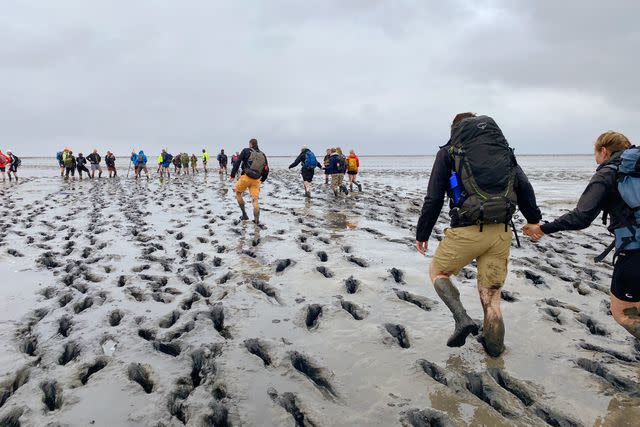
Lizzy Hewitt
A group of people mud walking in the NetherlandsOn the ferry to the mainland, the water was choppy and dark and, I observed with concern, there seemed to be a lot of it. In the dock parking lot, it was easy to spot my fellow wadlopers, in raincoats, shorts, and the recommended footwear: high-top Converse or, as in my case, knockoffs. The lightweight shoes fasten securely at the ankles, so they don’t get sucked off into the mud, and aren’t as weighed down by muck and water as hiking boots would be.
At low tide, when the water recedes one can walk long distances across the sea. Some 70,000 people go on treks of varying lengths each year, mostly in the summer, though hardcore enthusiasts explore year round.
Herman van der Geest, the coordinator of Wadloopcentrum Fryslan’s Ameland tour, greeted me. Tall, tan, and with a big smile, van der Geest has been exploring the Wadden Sea since childhood. He would be one of five volunteer guides leading our group of 54 across the Wadden Sea. Though guides carry GPS and compasses, they mostly navigate by experience. They walk with a long walking stick, handy for testing water depth.
Wadlopen requires a guide. The seabed changes frequently, necessitating adjustments to walking routes. Treks are scheduled by the tides, and, with the next high tide always only hours away, getting disoriented can quickly become dangerous.
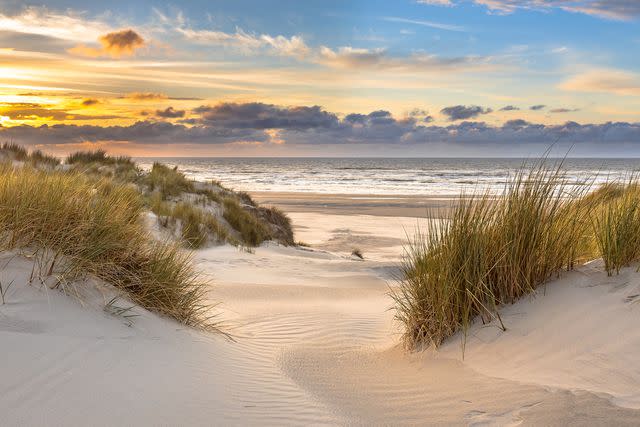
CreativeNature_nl/Getty Images
The island of Ameland, in the Netherlands.“You have a little time pressure,” van der Geest observed, when I asked why he loves it. “You just have to go. At some point there is no point of return.”
After an hour walk on land to the departure point, we began the crossing. First, the salt marsh. Johannes Herder, a guide-in-training, grabbed a sprig of slender leaves from the tall grass for me to taste: lambsoor, or sea lavender, like salty baby spinach. As the greenery became scarcer, he plucked a tender green shoot of zeekraal, a succulent sometimes called samphire that resembles mini asparagus. Restaurants covet the crisp, saline spears, he told me.
Related: There's a Beach Destination in the Netherlands You've Never Heard Of
Then, the slik. At first, it was easy to walk through the ankle-deep slurry, charcoal gray and smelling of sulfur. But ahead, the group abandoned the queue and fanned out. I could tell from uneasy laughs and flailing arms it was about to get tougher.
With each step I squelched almost knee deep into denser mud. Easier to follow in others’ footprints or break my own trail? Long strides or quick paces? I found a rhythm moving fast over unbroken mud. “Like skating,” another first-time wadloper observed as we glided across a shallower stretch.
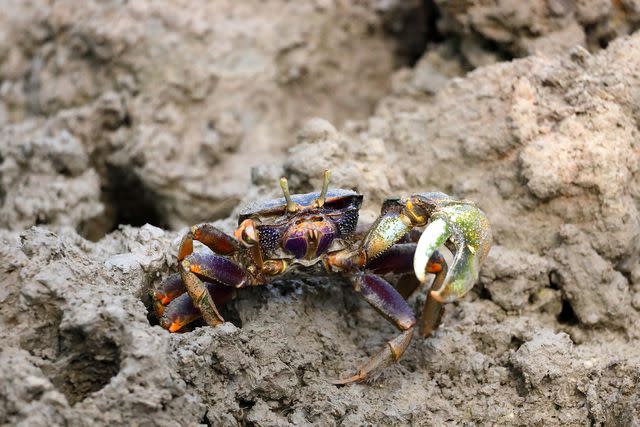
eugen_z/Getty Images
A fiddler crab in the mudflats.Half an hour later, we sloshed through water atop thin mud. Around us, the sea and clouds shimmered together. Ahead, something solid hovered, mirage-like, above the now-deeper water. Oyster beds, a guide told me. We came upon a reef of shells of cockles, oysters, and mussels. The ground crunched under each step.
Van der Geest collected a few oysters. He pried them open with a small knife and handed them around, producing a lemon-shaped squeeze bottle for garnish. He presented me the most perfect oyster I’d ever seen, loosening the flesh with the sharp teardrop blade. I slurped it down, savoring the fresh taste of the sea as I stood in the midst of it.
The route alternated between stretches of hardpacked sand and channels of flowing seawater, at times hip-deep. A flat-bottomed sailboat lolled on a bank, marooned until the tide returned. A seal basked nearby.
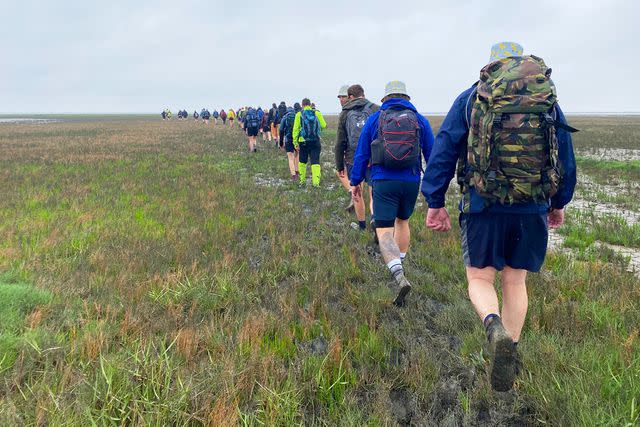
Lizzy Hewitt
The author's group hiking across a salt marsh.As we neared Ameland’s green dunes, a light rain began. I tucked my salty fingers into my sleeves and navigated the final stretch of shallow mud. When I climbed onto the grass, the sun broke through and wild roses perfumed the shore.
We crossed the narrow island to the sandy beach on the north coast and washed our legs in clean seawater. Trekkers piled barefoot into wooden trailers hitched to a tractor, chatting as our young driver sped along the beach to the island’s midpoint. From there, I walked back to my lodging in the village of Nes.
Amidst centuries-old brick houses and the agrarian landscape, the Wadden Sea already seemed distant. But at dinner that night at Binnen, under a piece of sea bass, I found sprigs of samphire — plush and fresh, like the one I sampled crossing the sea.
For more Travel & Leisure news, make sure to sign up for our newsletter!
Read the original article on Travel & Leisure.

